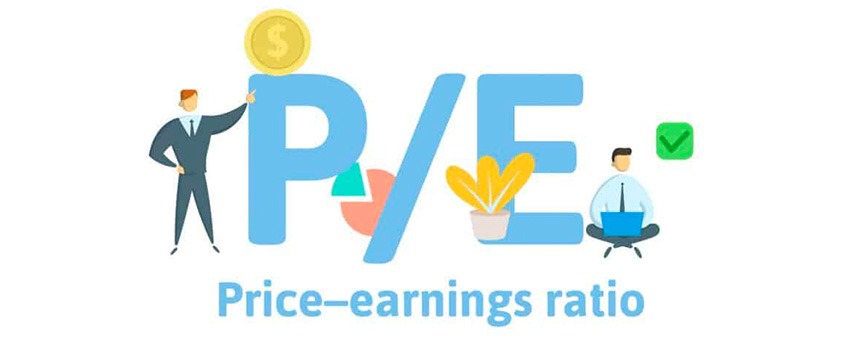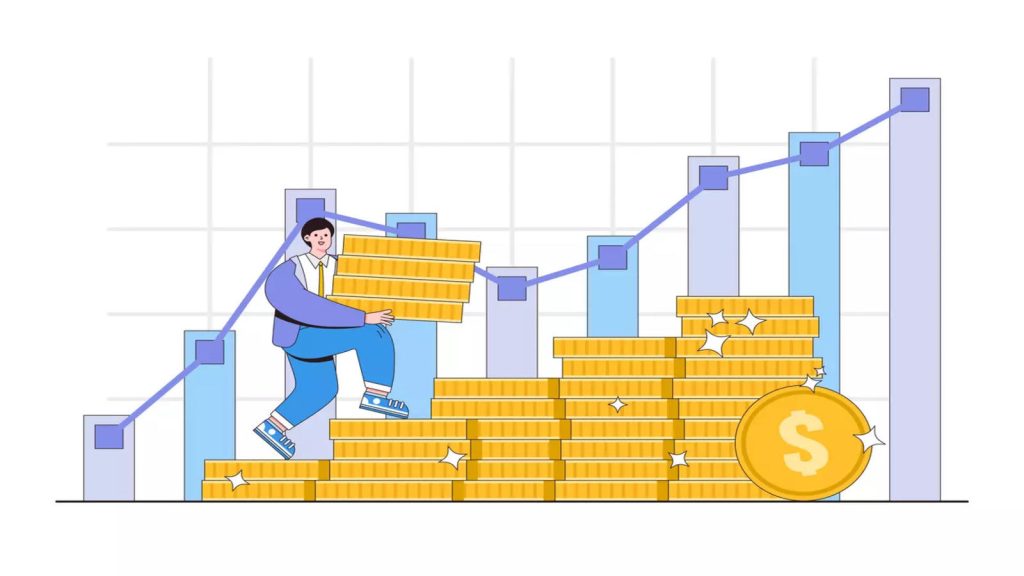Your cart is currently empty!
Price-to-Earnings Ratio (P/E Ratio) Calculator
What is the P/E Ratio Calculator?

A Price-to-Earnings (P/E) Ratio is a widely used financial metric that helps investors assess the relative valuation of a company’s stock. It compares a company’s current share price to its earnings per share (EPS), providing insight into how much investors are willing to pay for each dollar of earnings. A P/E Ratio Calculator simplifies the process of calculating this ratio, allowing investors to quickly determine whether a stock is potentially overvalued, undervalued, or fairly valued based on its earnings.
What is a P/E Ratio Calculator?
A P/E Ratio Calculator is an online or offline tool that simplifies the calculation of the P/E ratio. Users input the current stock price and the earnings per share (EPS) into the calculator. The tool then performs the division of the stock price by the EPS to provide the P/E ratio. This calculation helps investors quickly assess the valuation of a stock without manually performing the math. The calculator is particularly useful for making quick comparisons between different stocks or for evaluating changes in a single stock’s valuation over time.

How Do P/E Ratio Calculators Work?
P/E Ratio Calculators are designed to perform a simple yet crucial mathematical operation based on user-provided inputs. Here’s how they function:
Input Data:
- Stock Price: Users input the current stock price of a company.
- Earnings Per Share (EPS): Users input the earnings per share (EPS) of the company. EPS is typically calculated by dividing the company’s net profit by the number of outstanding shares.
Calculation:
The calculator divides the stock price by the EPS using the formula:P/E Ratio=Stock PriceEarnings Per Share (EPS)\text{P/E Ratio} = \frac{\text{Stock Price}}{\text{Earnings Per Share (EPS)}}P/E Ratio=Earnings Per Share (EPS)Stock Price
Output:
The result of this calculation is the P/E ratio, which the calculator displays. The P/E ratio indicates how much investors are willing to pay for each dollar of a company’s earnings.
Example: If a stock’s current price is $100 and its EPS is $5, the P/E ratio would be:P/E Ratio=1005=20\text{P/E Ratio} = \frac{100}{5} = 20P/E Ratio=5100=20
This means investors are willing to pay $20 for every $1 of earnings.
Importance and Usage of the P/E Ratio
The P/E ratio is an important tool for investors and analysts for several reasons:
- Valuation Insight:
- A high P/E ratio might indicate that a stock is overvalued or that investors expect high growth rates in the future.
- A low P/E ratio might suggest that a stock is undervalued or that the company is facing challenges.
- Comparative Analysis:
- The P/E ratio is useful for comparing the valuation of companies within the same industry or sector.
- It helps investors identify potential investment opportunities by comparing companies with similar growth prospects.
- Historical Comparison:
- Analyzing a company’s historical P/E ratios can help investors understand how its valuation has changed over time and the potential reasons behind these changes.
- Market Sentiment Indicator:
- The P/E ratio can reflect investor sentiment towards a company. High ratios may indicate strong investor confidence in future growth, while low ratios could suggest skepticism or concern about future performance.
Overall, P/E Ratio Calculators provide a quick and efficient way to evaluate stock valuations, aiding investors in making informed investment decisions.
How to Calculate the P/E Ratio Manually
While a calculator simplifies the process, understanding how to calculate the P/E ratio manually is valuable:
- Determine the Current Market Price per Share: This is the price at which the stock is currently trading.
- Calculate the Earnings Per Share (EPS): This is the company’s net income divided by the number of outstanding shares.
- Divide the Market Price per Share by the EPS: This gives you the P/E ratio.
Example:
If a company’s share price is $50 and its EPS is $5, the P/E ratio would be:P/E Ratio=505=10\text{P/E Ratio} = \frac{50}{5} = 10P/E Ratio=550=10
What is a Good P/E Ratio for Stocks?
The concept of a “good” P/E ratio can vary widely depending on several factors:
- Industry Standards: Different industries have different average P/E ratios. For instance, technology companies often have higher P/E ratios due to their growth potential, while mature industries like utilities might have lower P/E ratios.
- Company Growth Prospects: Companies with high growth potential often have higher P/E ratios. Investors are willing to pay a premium for stocks they believe will generate significant future earnings.
- Overall Market Conditions: Market valuations can fluctuate, affecting P/E ratios across the board. During bull markets, P/E ratios may be higher, while bear markets might see them decline.
General Interpretations:
- High P/E Ratio: Indicates that investors have high expectations for future earnings growth. This is common in growth sectors like technology or biotechnology.
- Low P/E Ratio: Suggests the stock might be undervalued or that the company is facing challenges. This is often seen in more stable, established industries or companies in distress.
To get a better understanding of a company’s valuation, it’s essential to compare its P/E ratio to its industry average and historical values.
P/E Ratio Calculator in Excel
Creating a P/E ratio calculator in Excel is straightforward and can be very helpful for investors who want to compare multiple companies quickly. Here’s how you can set it up:
- Columns Setup:
- Company Name
- Market Price per Share
- Earnings per Share (EPS)
- P/E Ratio
- Formula:
- In the P/E Ratio column, use a simple formula to divide the market price per share by the EPS. For example, if market price per share is in column B and EPS is in column C, the formula in column D would be
=B2/C2.
- In the P/E Ratio column, use a simple formula to divide the market price per share by the EPS. For example, if market price per share is in column B and EPS is in column C, the formula in column D would be
This allows for easy comparison of multiple companies, helping investors make better-informed decisions.
P/E Ratio vs. P/B Ratio: Understanding the Differences
While both the P/E ratio and the P/B ratio (price-to-book ratio) are valuation metrics, they focus on different aspects of a company’s financial health:
- P/E Ratio: Compares a company’s share price to its earnings. It’s more forward-looking as it reflects investor expectations of future earnings. It is particularly useful in assessing companies with consistent earnings growth.
- P/B Ratio: Compares a company’s share price to its book value per share. It’s more backward-looking as it focuses on the company’s historical cost of assets. It is useful for valuing companies with significant tangible assets, like banks and manufacturing firms.
Key Takeaways:
- The P/E ratio is a measure of the price paid for a share relative to the annual net income or profit earned by the firm per share.
- The P/B ratio provides a snapshot of the company’s value based on its assets and liabilities, offering insight into whether a stock is potentially undervalued based on its net asset value.
Both ratios should be used together to get a more comprehensive view of a company’s valuation. For example, a high P/E ratio coupled with a low P/B ratio might indicate that while the company is generating good earnings, its asset base is undervalued, providing a potentially lucrative investment opportunity.
Factors Affecting P/E Ratios
Several factors can influence a company’s P/E ratio, including:
- Earnings Growth: Companies with high earnings growth potential typically have higher P/E ratios, as investors expect future profits to increase.
- Interest Rates: Lower interest rates generally lead to higher P/E ratios, as the cost of borrowing is cheaper and investors are willing to pay more for future earnings.
- Market Conditions: Bull markets often see higher P/E ratios due to increased investor confidence, while bear markets can drive P/E ratios lower as pessimism sets in.
- Investor Sentiment: Market psychology plays a significant role in determining stock valuations. A company’s P/E ratio can fluctuate based on news, market trends, or changes in economic policy.
Conclusion
Understanding the P/E ratio is crucial for making informed investment decisions. It provides a snapshot of a company’s valuation based on its earnings and is widely used for comparing companies within the same industry. However, it’s important to use the P/E ratio in conjunction with other financial metrics, like the P/B ratio, to get a comprehensive view of a company’s financial health.
By utilizing tools like a P/E Ratio Calculator, investors can quickly assess the valuation of stocks, identify potential investment opportunities, and make strategic decisions based on sound financial data. Whether used online, offline, or in Excel, these calculators serve as a fundamental component of any investor’s toolkit, enabling a deeper understanding of market dynamics and stock performance.
Dividend Yield Calculator
What is the Dividend Yield?
Dividend yield is a financial ratio that shows how much a company pays out in dividends each year relative to its stock price. It is expressed as a percentage and is calculated by dividing the annual dividends per share by the current stock price per share. Dividend yield provides investors with an indication of the income they can expect to receive from an investment in a particular stock, based on the current market price. It is particularly useful for income-focused investors who seek regular income through dividends.

What is a Dividend Yield Calculator?
A dividend yield calculator is a tool designed to help investors quickly and easily determine the dividend yield of a stock. By inputting the annual dividend per share and the current stock price, the calculator computes the dividend yield, expressed as a percentage. This tool is valuable for investors who want to assess the income-generating potential of different stocks and compare them to make informed investment decisions. It eliminates the need for manual calculations and provides an immediate result, making it easier for investors to evaluate their potential returns from dividends.
A stock market with high dividends refers to a collection of companies that distribute a significant portion of their earnings to shareholders in the form of dividends. These companies typically have mature business models, generating steady cash flows that allow them to consistently pay dividends.
Key Characteristics of High Dividend Stocks:
- Mature Companies: Often established businesses with stable revenue streams.
- Consistent Profitability: Generate regular profits to sustain dividend payments.
- Lower Growth Potential: Typically, these companies have reached a growth plateau, focusing on returning profits to shareholders rather than reinvesting for rapid expansion.
- Higher Dividend Yield: Offers a higher percentage return on investment compared to other stocks.
Benefits of Investing in High Dividend Stocks:
- Regular Income: Provides a steady stream of income, especially beneficial for retirees or those seeking income generation.
- Potential for Capital Appreciation: While growth may be slower, stock prices can still appreciate over time.
- Reduced Volatility: Often less volatile than growth stocks, providing a degree of stability.
Risks of Investing in High Dividend Stocks:
- Lower Growth Potential: As mentioned, these companies often have limited growth prospects.
- Dividend Cuts: Companies may reduce or eliminate dividends during economic downturns or financial difficulties.
- Higher Tax Implications: Dividends are generally taxable, which can impact overall returns.
Popular Sectors for High Dividend Stocks:
- Utilities: Companies providing essential services like electricity, gas, and water.
- Telecommunications: Companies offering phone, internet, and television services.
- Real Estate Investment Trusts (REITs): Own and operate income-generating real estate.
- Consumer Staples: Companies producing essential goods like food, beverages, and household products.
Important Considerations:
- Dividend Yield: This is the annual dividend per share divided by the stock price. A higher yield indicates a larger portion of earnings is returned to shareholders.
- Dividend Payout Ratio: This ratio compares dividends paid to net income. A high payout ratio might indicate a company is distributing a significant portion of earnings, potentially limiting future growth.
- Dividend Growth: Look for companies with a history of increasing dividends, signaling financial health and commitment to shareholders.
- Diversification: Spread your investments across different sectors to reduce risk.
By carefully analyzing these factors, investors can build a portfolio of high dividend stocks that aligns with their financial goals and risk tolerance.
How Do Dividend Yield Calculators Work?
Dividend yield calculators work by performing a simple mathematical calculation based on two key inputs: the annual dividend per share and the current stock price. Here’s how they function:
- Input Values: The user inputs the annual dividend per share and the current stock price into the calculator. The annual dividend per share is the total dividend paid out by the company over the past year for each share of stock. The current stock price is the market price of one share of the company’s stock.
- Calculate Dividend Yield: The calculator divides the annual dividend per share by the current stock price. The result is then multiplied by 100 to convert it into a percentage.
- Output Result: The calculator displays the dividend yield as a percentage. This output helps investors understand how much income they can expect to receive from dividends relative to the amount they invest in purchasing the stock.
By automating this calculation, dividend yield calculators save time and reduce the potential for errors, providing investors with a quick and accurate way to assess the dividend income potential of different stocks.
FinQuiz
Which company developed Material Design?

Download The Financial Calculator App
Discover all the incredible features of our app designed to enhance your experience. From intuitive tools to unique services tailored for your needs, the app offers endless possibilities. Don’t miss out—click the link below to learn more and see how it can make a difference in your life today.

Whether you’re a seasoned investor or just starting out, our financial astrology tools can be tailored to your specific investment goals. Gain valuable insights to achieve your financial aspirations.
Address
1301, 13th Floor, Skye Corporate Park, Near Satya Sai Square, AB Road, Indore 452010
+91 9669919000
© All Rights Reserved by RajeevPrakash.com (Managed by AstroQ AI Private Limited) – 2025